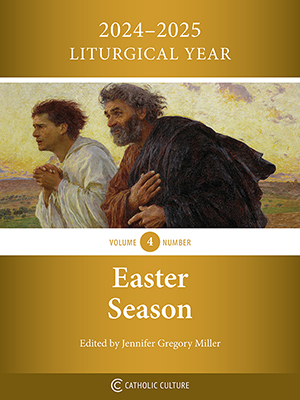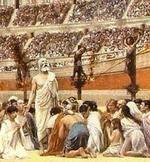The ‘self-referential’ Synod
By Phil Lawler ( bio - articles - email ) | Aug 14, 2024
“The entire synodal process has been, and remains, inward-looking,” writes Francis X. Maier in The Catholic Thing. Therein lies one of the greatest ironies of this troubled and troubling pontificate.
Free eBook:

|
| Free eBook: Liturgical Year 2024-2025, Vol. 4 |
Several of the cardinals who participated in the papal election of 2013 have reported that the pro-Bergoglio tide began to rise when, in the conferences that took place before the conclave, the cardinal from Argentina spoke of the weakness of a “self-referential” Church. Now, as we move toward the culminating event of what was once expected to be a reforming papacy, the action in Rome is more inward-looking, more “self-referential,” than ever.
For three long years Pope Francis and the prelates he has chosen to lead the Synod on Synodality have stressed the necessity of developing a “synodal” Church: a process that would begin, they said, with a broad consultation among all the People of God. But as we wearily approach the October meeting of the Synod, most Catholics are still seeking an answer to the most basic question: What does “synodality” mean?
Still more important, although the preparations for this Synod have unquestionably been extensive, they have not been broad enough to involve more than a tiny percentage of the active Catholic laity—although the organizers have gone to unprecedented lengths to include dissident Catholics, lapsed Catholics, and non-Catholics in their discussions. The working document for the October session, the Instrumentum Laboris, indulges in a great deal of self-congratulatory rhetoric about the excitement that the preparatory process has created. But that excitement does not extend far beyond the Synod organizers. Maier remarks on the “unintended candor” of one telling sentence in the Instrumentum: “The circularity of the synodal process recognizes and enhances the Church’s rootedness in various contexts, serving the bonds that unite them.”
In July, hoping to stir up a bit more public enthusiasm, Synod organizers conducted an online poll, asking: “Do you believe that synodality as a path to conversion and reform can enhance the mission and participation of all the baptized?” When the early responses shows an overwhelming (88%) negative response, the organizers took down the poll. So much for broad consultation.
After past meetings of the Synod of Bishops, critics complained that the Vatican organizers had tightly controlled the agenda. But this time the preparatory process has aggravated the problem. Maier reports:
I served as the on-location aide to a delegate at three synods in Rome: 1997, 2015, and 2018. All of them, to one degree or another, suffered from complicated procedures and a sometimes-heavy curial hand. But the synod on synodality sets a new standard in tedious theater.
Throughout his pontificate, Francis has promised to decentralize the governance of the Catholic Church and to de-emphasize the institutional structures. But the process of consultation inevitably concludes with a call for further consultation; the reliance on dialogue requires more dialogue still. So the Instrumentum suggests “a recognized and properly instituted ministry of listening and accompaniment which would make this characteristic feature of a synodal Church an enduring and tangible reality.” Maier translates accurately: “In other words, another brick in the institutional edifice.”
In the early days of his pontificate, Pope Francis raised the expectations of many Catholics (myself included) by emphasizing the priority of the Church’s evangelizing mission. He still asserts that this Synod will enhance that mission, but it is difficult to see how. “The trouble is that ‘missionary’ and ‘synodality’ don’t persuasively fit together,” Maier concludes.
Exactly. Try to imagine what would happen if, per impossibile, this Synod delivered on its promises, as the Pope and the Instrumentum now describe them. The Catholic Church would then boast a new and improved decision-making process; the faithful and the hierarchy would “walk together” in harmony. All very good in theory. But what would it mean in practice, as applied to the evangelical mission? Could we expect to draw people toward the Catholic faith by promising them an efficient decision-making structure, or a more robust dialogue?
In practice, the approach favored by the Synod organizers seems to have produced quite the opposite of a missionary impulse. In Germany, whose bishops have strolled the furthest down the Synodal Path, the turnstiles are kept whirling by the thousands of people rushing out of the Catholic Church. The promise of “synodality” has already proven far less enticing than the “hard saying” of Chapter Six in St. John’s Gospel.
Synodality, whatever that term means, is at best a means, not an end: an aid to mission, not the mission itself. At worst it is a distraction from that mission. A “synodal” Church might speak with a single voice, but it would still need something to say. The mission of the Church—the message—is expressed by the Lord clearly enough: to “make disciples of all nations, baptizing them in the name of the Father and of the Son and of the Holy Spirit, teaching them to observe all that I have commanded you.”
All comments are moderated. To lighten our editing burden, only current donors are allowed to Sound Off. If you are a current donor, log in to see the comment form; otherwise please support our work, and Sound Off!
-
Posted by: Lucius49 -
Aug. 20, 2024 10:02 PM ET USA
Synods have existed througout church history yet enormous time, money, and energy are being spent on discussions about the concept of synod. Meanwhile large sectors of the Church are awash in heresy and apostasy. It was just reported that confessions are almost non-existent in Germany. Thus can it be asked that whether this synodality confab is a church a sad enactment of the phrase “fiddling while Rome burns?” Libera nos Domine.
-
Posted by: ewaughok -
Aug. 19, 2024 5:24 PM ET USA
Thanks, Mr. Lawler for this well thought-out post. I think one of the big irony from this attempt to do an end run around Vatican II, and what it actually says, for example, in Lumen Gentium, on the constitution of the Church, is that it is ending up by pushing the Church into a structure something like the “Old Catholics”, a mostly German splinter sect that split off from the Church after Vatican I. Such is the loopy leadership in Rome at present …
-
Posted by: rfr46 -
Aug. 19, 2024 3:43 AM ET USA
This synodality movement is an admission of failure of the leadership of the Church. It is a closed shop. A put up job directed by PF sycophants. They have no interest in listening to the faithful who do not agree with them. Calling this a listening movement is profoundly dishonest.
-
Posted by: feedback -
Aug. 14, 2024 12:36 PM ET USA
"...they have not been broad enough to involve more than a tiny percentage of the active Catholic laity." Even that hand-piocked tiny percentage (e.g.: James Martin SJ) do not represent anything close to the heart of majority of practicing Catholics. Enthusiasts of this charade bring to mind the enthusiastic lackeys from "The Emperor's New Clothes."
-
Posted by: miketimmer499385 -
Aug. 14, 2024 11:23 AM ET USA
Your concluding paragraph succinctly sums up all we need to know about this frenetic endeavor. What a shame.







